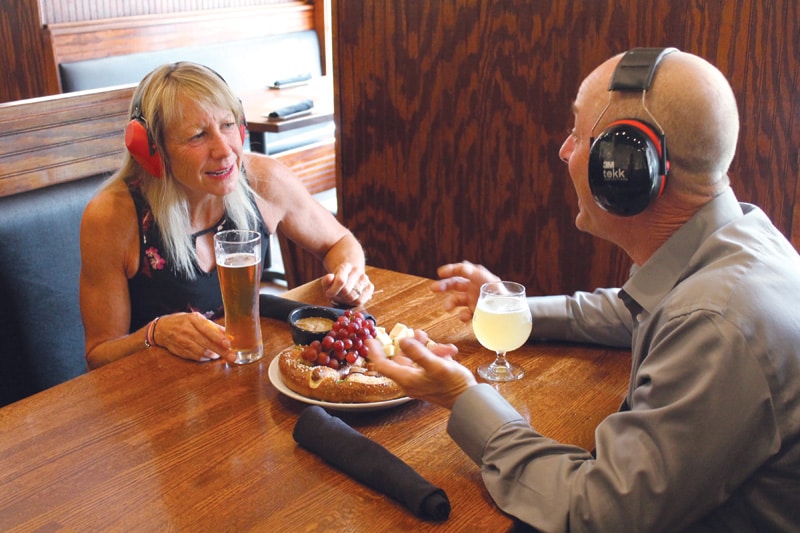A Recipe for a Disturbing Dining Experience
Does noise detract from your meal?

As more than a medical term, “heartbeat” reaches deeper: the heartbeat of a band, a city, a family – the roots, the pulse, what keeps it in motion.
I recently heard “heartbeat” regarding a restaurant: the hum of conversation, background music and wait staff. The heartbeat creates the atmosphere and amplifies the experience of dining out.
But what about when that heartbeat is more like a cardiac arrest? Dining out is a great way to relax, unwind and catch up with friends, but there’s nothing more frustrating than having to strain to hear what your dining companions are saying.
YOU’RE NOT ALONE. AND NO, IT’S NOT JUST YOUR AGE.
It can be easy for boomers to assume that their impatience with noisy restaurants correlates with being over 50, but complaints about noise are widespread. The 2016 national dining trends survey from Zagat restaurant guides found that diners’ No. 2 pet peeve nationally was noise (at 25 percent, second only to poor service, which got 28 percent). Diners in several large cities – New York City, Boston, San Francisco and Portland, Oregon – cite noise as their chief complaint.
And aside from the obvious conversational challenges, a loud restaurant can exacerbate stress and reduce relaxation while posing problems in communicating with the wait staff. A 2014 research study discovered that loud noise can even adversely affect the perceived taste, flavor and texture of food. And for diners who already have some noticeable hearing loss, overuse of “Say what?” can be a bit embarrassing.
Restaurant reviewer Tom Sietsema had received noisy-restaurant complaints from both genders and a range of ages. In 2008, Sietsema began including noise ratings in The Washington Post, providing a breakdown of his ratings by decibel level: quiet (under 60 decibels); conversation is easy (60-70 decibels); must speak with raised voice (71-80, like city traffic); and extremely loud (over 80, vacuum-cleaner, screaming-child or lawn-mower loud).
WHY, OH WHY?
Needless to say, this is still a widespread issue. So why are so many restaurants still guilty of it?
In many cases, it can depend on the venue and what the owners are trying to achieve. If high turnover is a restaurant’s goal, excessive background noise is a great way to turn tables. Studies found that patrons drank faster, consumed more and left more quickly as music increased in volume. These restaurants’ idea of a “heartbeat” is more like a “drumbeat.”

THEY’RE NOT ALL TRYING TO BURST YOUR EARDRUMS
This doesn’t mean, however, that every restaurant is trying to get you in one door and out the other before you can say “check, please.” Particularly for locally owned spots, restaurateurs want their patrons to be satisfied, happy and write nice Yelp reviews.
On the other hand, increased volume reflects the business’s necessary goal. “It’s a catch-22,” says Chris Tsui, owner of EAT Restaurant Partners (EAT’s many Richmond dining establishments include Fat Dragon, Foo Dog, Wild Ginger, Osaka and Wong Gonzalez). “If you did the place right, it gets busy and it’s going to be loud.”
Furthermore, you may have noticed the recent elegant yet reverberating decorating trend among restaurants: minimalism. Large windows, exposed brick, bare countertops, high ceilings. According to Jay Bayer, owner of Saison, the new Mexican restaurant Flora and a new “bar-cade” concept in Scott’s Addition, “As design has gone so minimal the past decade, the opportunity to mitigate sound has become difficult.” The design is delightful on the eyes (so clean, so chic), but frustrating on the ears (like the echo of a cave).
ACOUSTICAL SOLUTIONS
Paige Healy, concept developer for Casa del Barco and all four Boathouse restaurants (Rocketts Landing, Sunday Park, Short Pump and Hopewell), shared some noise-softening acoustical solutions, including cushioned seats, fabric, and wood instead of metal when possible.
Her most reliable acoustical solution, however, is Acoustical Solutions. The Richmond-based company provides sound absorption products to local restaurants to ensure you and your dining companions can speak, not shout.
Per Ryan Larkin, marketing communications coordinator for Acoustical Solutions, “[Restaurant owners] may simply not be aware that they have a sound problem or not know what they can do to solve it.” Acoustical Solutions comes to the rescue with discreet sound barriers to help absorb and regulate noise more easily.
On the downside, however, sound paneling can be expensive and is often a budgeting afterthought. This is particularly true for new places that are more focused on perfecting their cuisine, hiring the right staff and simply surviving that crucial first month.
THE HEARTBEAT
Here’s something else to think about: many restaurateurs don’t want their atmosphere to be too quiet. A bustling vibe creates energy and invokes a vibrant setting.
“When you’re running, it has tempo. We want to share that [same type of] energy with our customers … it’s the heartbeat of our restaurant,” Healy explains. She went on to say that they don’t want it to be hushed, like a library, which would drastically alter the mood.
Or, as one local brewery manager says, “like a morgue.”
Tsui concurs: “[A loud restaurant] creates more excitement.”
SOME SOLUTIONS OF YOUR OWN
But maybe you’re not really an “exciting atmosphere” kind of person and prefer too-quiet to too-noisy. So if dining in a loud restaurant still seems like more of a hassle than it’s worth, consider these options:
- Go earlier in the evening, or even earlier in the week, when crowds are thinner.
- Perhaps even choose lunch over dinner.
- Keep a list of favorite quiet restaurants for times you want to catch up and converse.
- When possible, request a table away from speakers or televisions. Tables further from the bar and the kitchen also tend to be calmer.
- Since buffering noise costs money, expect the bill at a quiet venue to reflect that.
- Plenty of restaurants improve acoustics after opening, so consider giving a new noisy restaurant a second chance.
- At restaurants with soft volume, express appreciation (on social media and to the manager). At those with high volume, nicely express your desire for less noise. Maybe we can start a trend.
In any case, don’t write off dining out altogether. Just relax; enjoy the atmosphere, enjoy the company and, most importantly, enjoy the heartbeat.


